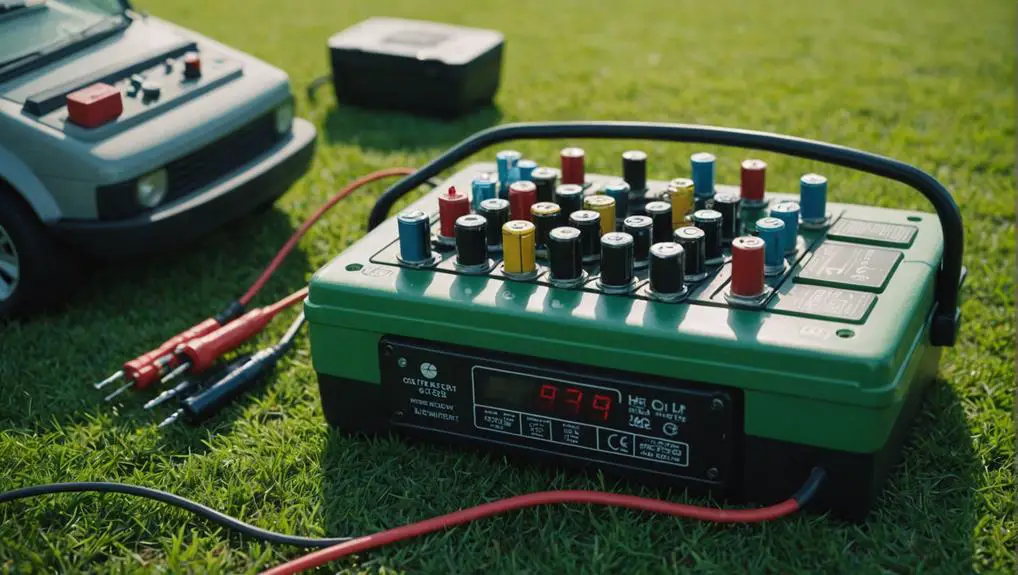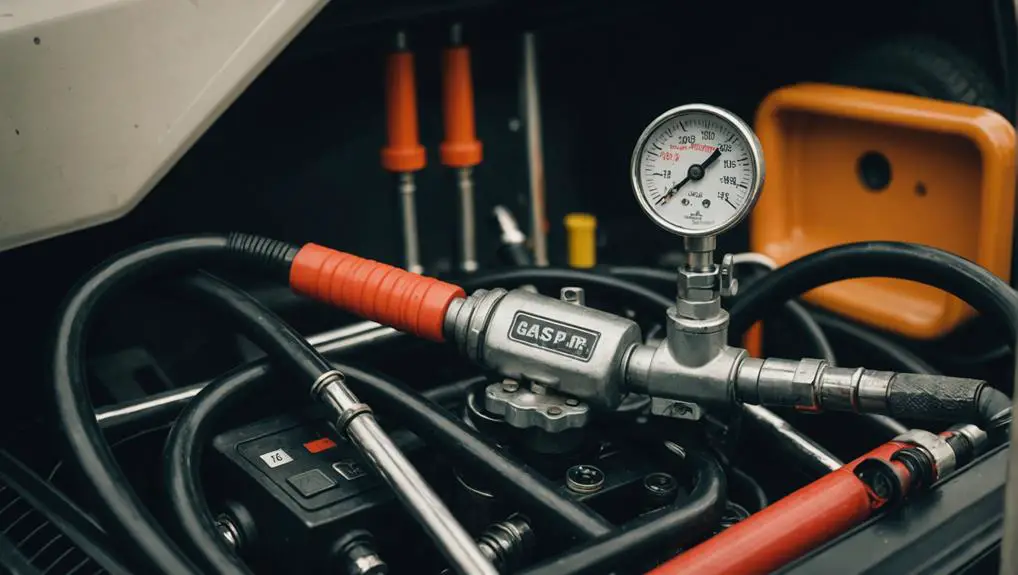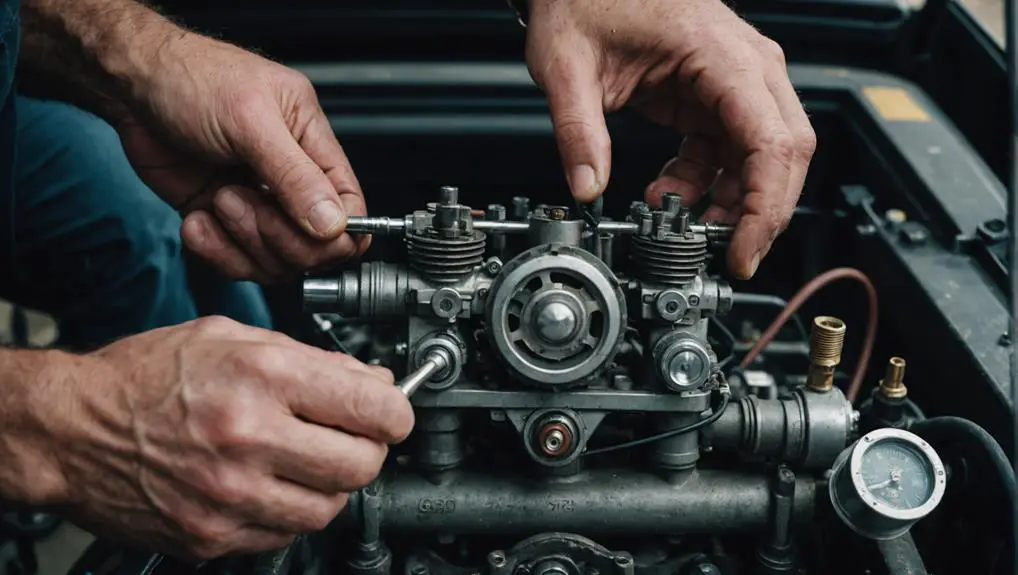A golf cart that won't start can feel like a locked door, keeping you from the freedom of the open course. You might find yourself frustrated as the engine turns over but fails to roar to life. To tackle this issue effectively, you need to start by examining the fuel system, checking for blockages, and ensuring everything flows smoothly. But that's just the beginning; there are other critical components you'll want to investigate before hitting a dead end. What's the next step you should take to reveal the mystery behind your cart's stubbornness?
Key Takeaways
- Check fuel level and quality; ensure the tank is full and use high-quality fuel for optimal engine performance.
- Inspect fuel lines and filter for leaks, blockages, or clogs to guarantee proper fuel delivery to the engine.
- Test the battery voltage and connections; clean terminals and ensure secure connections to avoid electrical issues.
- Examine the ignition switch and wiring for damage or loose connections that may prevent the starting system from functioning properly.
- Measure engine compression using a gauge; ensure readings are within 90-120 psi to confirm proper engine health.
Check the Fuel System
When troubleshooting your EZ GO gas golf cart, the first step is to check the fuel system.
Begin by inspecting the fuel tank to make certain it has an adequate amount of gasoline. If the tank is empty or nearly empty, refill it with high-quality fuel.
Next, examine the fuel lines for any signs of leaks, cracks, or blockages. Damaged fuel lines can restrict fuel flow, leading to starting issues.
Then, check the fuel filter. A clogged fuel filter can prevent fuel from reaching the engine. If it looks dirty or hasn't been replaced in a while, replace it.
After that, verify that the fuel pump is functioning correctly. You can do this by listening for a humming sound when you turn the ignition key to the "on" position. If you don't hear anything, the pump may be faulty.
Inspect the Spark Plug
Inspecting the spark plug is essential for ideal engine performance in your EZ GO gas golf cart.
Start by checking for any visible damage, such as cracks or excessive wear, which can hinder ignition.
If the spark plug appears dirty or worn, clean it or replace it to guarantee reliable operation.
Check for Damage
A essential step in diagnosing issues with your EZ GO gas golf cart involves checking the spark plug for damage.
The spark plug plays a significant role in igniting the air-fuel mixture within the engine. If it's damaged, your cart won't start despite turning over.
Here are three key areas to inspect:
- Electrode Condition: Examine the electrodes for wear or erosion. If they appear burned or excessively worn, this could hinder spark generation.
- Insulator Cracks: Check the porcelain insulator for any visible cracks or chips. These defects can lead to misfires and prevent effective ignition.
- Carbon Build-up: Look for any carbon deposits on the spark plug. Heavy build-up can insulate the electrodes, reducing spark intensity.
Clean or Replace
Your EZ GO gas golf cart's performance hinges on a properly functioning spark plug, so cleaning or replacing it can greatly impact its reliability.
Start by locating the spark plug, usually found on the engine's cylinder head. Using a socket wrench, remove the spark plug carefully. Inspect it for signs of wear or carbon buildup. If the electrode is worn or the insulator is cracked, you'll need to replace it.
If the spark plug appears dirty but intact, you can clean it. Use a wire brush or a specialized spark plug cleaner to remove carbon deposits. After cleaning, check the gap between the electrodes using a feeler gauge; it should match the manufacturer's specifications. If it's incorrect, adjust it carefully.
Once you're done, reinsert the spark plug, ensuring it's snug but not overly tight to avoid damaging the threads. Reconnect the ignition wire, and you're set.
Regularly inspecting and maintaining your spark plug will enhance your golf cart's performance and longevity. If you've cleaned or replaced the spark plug and the cart still won't start, you may need to investigate other components, like the ignition system or fuel delivery.
Test the Battery

To guarantee your EZ GO gas golf cart runs efficiently, you must test the battery.
Start by checking the voltage levels to confirm they're within the acceptable range.
Next, inspect the battery connections for any corrosion and test the load capacity to assess overall performance.
Check Battery Voltage Levels
Checking battery voltage levels is vital for diagnosing issues with your EZ GO gas golf cart. A weak or dead battery can prevent your cart from starting, even if it turns over.
You'll want to measure the voltage to guarantee it's within the proper range.
Here's what you need to do:
- Use a Multimeter: Set it to the DC voltage setting and connect the probes to the battery terminals.
- Read the Voltage: A fully charged battery should read around 12.6 volts or higher. If it's below 12.4 volts, it may need charging.
- Under Load Test: If you suspect the battery has issues, perform a load test using a load tester to see how it holds up under pressure.
If you find that the battery voltage is insufficient, it's time to recharge or replace the battery.
Remember that a fully functional battery is vital for your cart's performance. Monitoring these levels regularly can save you from unexpected breakdowns and extend the life of your battery.
Inspect Battery Connections
After verifying the battery voltage, the next step involves inspecting the battery connections.
Start by confirming that the battery terminals are clean and free from corrosion. Corroded connections can prevent proper electrical flow, leading to starting issues. Use a wire brush or a battery cleaning solution to remove any buildup.
Next, check the tightness of the connections. Loose cables can intermittently disrupt power delivery. Use a wrench to tighten the terminal bolts securely, but avoid overtightening, as this can damage the terminals.
Also, inspect the cables for any signs of fraying, cracking, or other damage. Damaged cables can impair performance and may need replacing.
It's important to confirm that the positive and negative terminals are correctly connected. The positive terminal should connect to the positive cable, and the same applies to the negative terminal.
Test Battery Load Capacity
Testing the battery load capacity is essential for guaranteeing your EZ GO gas golf cart operates efficiently. A weak or failing battery can lead to starting issues, even if the engine turns over.
Here's how to effectively test the battery:
- Use a Load Tester: This tool applies a load to the battery and measures its ability to hold voltage under stress.
- Check Voltage: Before testing, measure the battery's voltage with a multimeter. It should read around 12.6 volts or more when fully charged.
- Perform the Load Test: Connect the load tester to the battery terminals. Apply a load that's half the battery's amp-hour rating for 10-15 seconds. The voltage shouldn't drop below 9.6 volts during this test.
If your battery fails to maintain adequate voltage during the load test, it's likely time for a replacement. Regular testing can prevent unexpected failures and guarantee your golf cart remains reliable.
Always handle batteries with care, and wear protective gear to avoid potential hazards. By keeping your battery in top condition, you'll enhance the overall performance of your EZ GO golf cart.
Examine the Ignition Switch
The ignition switch is a critical component in your EZ GO gas golf cart's starting system. If your cart turns over but won't start, the ignition switch could be the culprit. Start by visually inspecting the switch for any signs of damage or corrosion. If you notice any wear or corrosion, it's important to replace the switch to guarantee proper functionality.
Next, use a multimeter to test the voltage at the ignition switch. Set the multimeter to the DC voltage setting and connect the leads to the input and output terminals of the switch. You should see a consistent voltage reading when the key is turned to the "On" position. If there's no voltage or an inconsistent reading, the ignition switch is likely faulty.
Also, examine the wiring connected to the switch. Look for loose connections, frayed wires, or any signs of shorts. Secure any loose connections and replace damaged wires as necessary.
This thorough examination of the ignition switch and its connections will help you identify any issues that might prevent your EZ GO gas golf cart from starting properly.
Evaluate the Fuel Pump

Evaluating the fuel pump is vital when troubleshooting why your EZ GO gas golf cart won't start. A malfunctioning fuel pump can prevent the engine from receiving the necessary fuel, leading to starting issues.
Here are three key aspects to check:
- Fuel Supply: Confirm there's sufficient fuel in the tank. Sometimes, it's as simple as an empty tank.
- Pump Operation: Listen for the fuel pump's sound when you turn the key. If you don't hear it, the pump may be faulty or not receiving power.
- Fuel Lines: Inspect the fuel lines for any blockages or leaks. A clogged line can hinder fuel flow, while a leak can lead to loss of pressure.
Once you've checked these items, you can further assess the pump's functionality.
Remove the fuel pump and test it with a multimeter to verify it's receiving the correct voltage. If it's defective, replacing the pump is your next step.
Assess the Wiring Connections
Many issues with an EZ GO gas golf cart can stem from faulty wiring connections, making it crucial to assess these components thoroughly. Start by inspecting the battery terminals. Confirm they're clean and securely connected. Corrosion can build up, leading to poor electrical flow; if you see any, clean it using a mixture of baking soda and water.
Next, check the wiring harness for any visible damage. Look for frayed wires, loose connections, or burnt insulation. If you find any issues, repair or replace the affected components. Pay special attention to the ignition switch wiring, as a loose connection here can prevent the cart from starting.
Additionally, examine the ground connections. A poor ground can disrupt the entire electrical system. Confirm that all ground wires are tightly connected to a clean, bare metal surface on the frame.
Review Engine Compression

Engine compression is essential for your EZ GO gas golf cart's performance and efficiency. If your cart turns over but won't start, low compression might be the culprit.
To diagnose this issue, you'll want to check a few critical factors:
- Piston Rings: Worn or damaged piston rings can lead to compression loss, preventing the engine from building the necessary pressure.
- Cylinder Head Gasket: A blown or leaking gasket can allow air to escape, resulting in insufficient compression.
- Valves: Improperly sealing valves can also contribute to low compression, as they may not close fully during the compression stroke.
To measure engine compression, use a compression gauge. Remove the spark plug, insert the gauge, and crank the engine. Ideally, your readings should be between 90-120 psi.
If the readings are below this range, it indicates a potential issue with one or more of the components mentioned.
Once you've identified the problem, you can proceed with repairs, which may include replacing piston rings, gaskets, or adjusting the valves.
Regular maintenance will help guarantee peak engine performance and longevity.
Frequently Asked Questions
What Tools Are Needed for Troubleshooting a Gas Golf Cart?
To troubleshoot a gas golf cart, you'll need a few essential tools.
Start with a multimeter to check electrical components, a spark plug socket for inspecting spark plugs, and a basic set of wrenches for loosening and tightening various parts.
You might also want a fuel pressure gauge to assess the fuel system.
Don't forget safety gear like gloves and goggles to protect yourself while working on the cart.
How Do I Know if My Fuel Is Old or Bad?
To determine if your fuel's old or bad, check its color and smell.
Fresh gasoline is typically clear or slightly yellow and has a gasoline odor. If it appears dark or has a sour smell, it's likely degraded.
You can also look for sediment or cloudy appearance in the tank.
If the fuel's been sitting for more than a month, it's best to replace it with fresh gasoline to guarantee peak performance.
Can Weather Affect My Golf Cart's Starting Ability?
Just like a flower wilts in harsh weather, your golf cart's starting ability can suffer due to environmental conditions.
Cold temperatures can thicken oil and hinder battery performance, while extreme heat may evaporate fuel or affect electrical components.
Humidity can lead to moisture in the fuel system, causing starting issues.
To guarantee peak performance, keep your cart sheltered during inclement weather and regularly check fluids and battery health.
Where Can I Find Replacement Parts for My EZ GO Golf Cart?
You can find replacement parts for your EZ GO golf cart at various sources.
Start by checking authorized dealers or the manufacturer's website, as they often have an extensive selection of OEM parts.
Online marketplaces like eBay or Amazon also offer a range of aftermarket options.
Local automotive or golf cart repair shops might stock common components too.
Make certain to compare prices and read reviews to guarantee you're getting quality parts.
How Often Should I Perform Maintenance on My Golf Cart?
Think of your golf cart as a finely-tuned orchestra, requiring regular rehearsals to keep the music playing smoothly.
You should perform maintenance at least once a season, but if you use it frequently, consider quarterly checks.
Inspect the battery, brakes, and tires regularly, and keep an eye on the oil and fuel filters.
Regular maintenance extends your cart's life and guarantees a harmonious ride every time you hit the course.
Conclusion
In troubleshooting your EZ GO gas golf cart, remember that "a stitch in time saves nine." By systematically checking the fuel system, spark plug, battery, ignition switch, fuel pump, wiring connections, and engine compression, you can pinpoint the issue effectively. Addressing these components will not only help you get your cart running again but also prevent future problems. Taking these steps guarantees your golf cart stays reliable on the course. Happy driving!